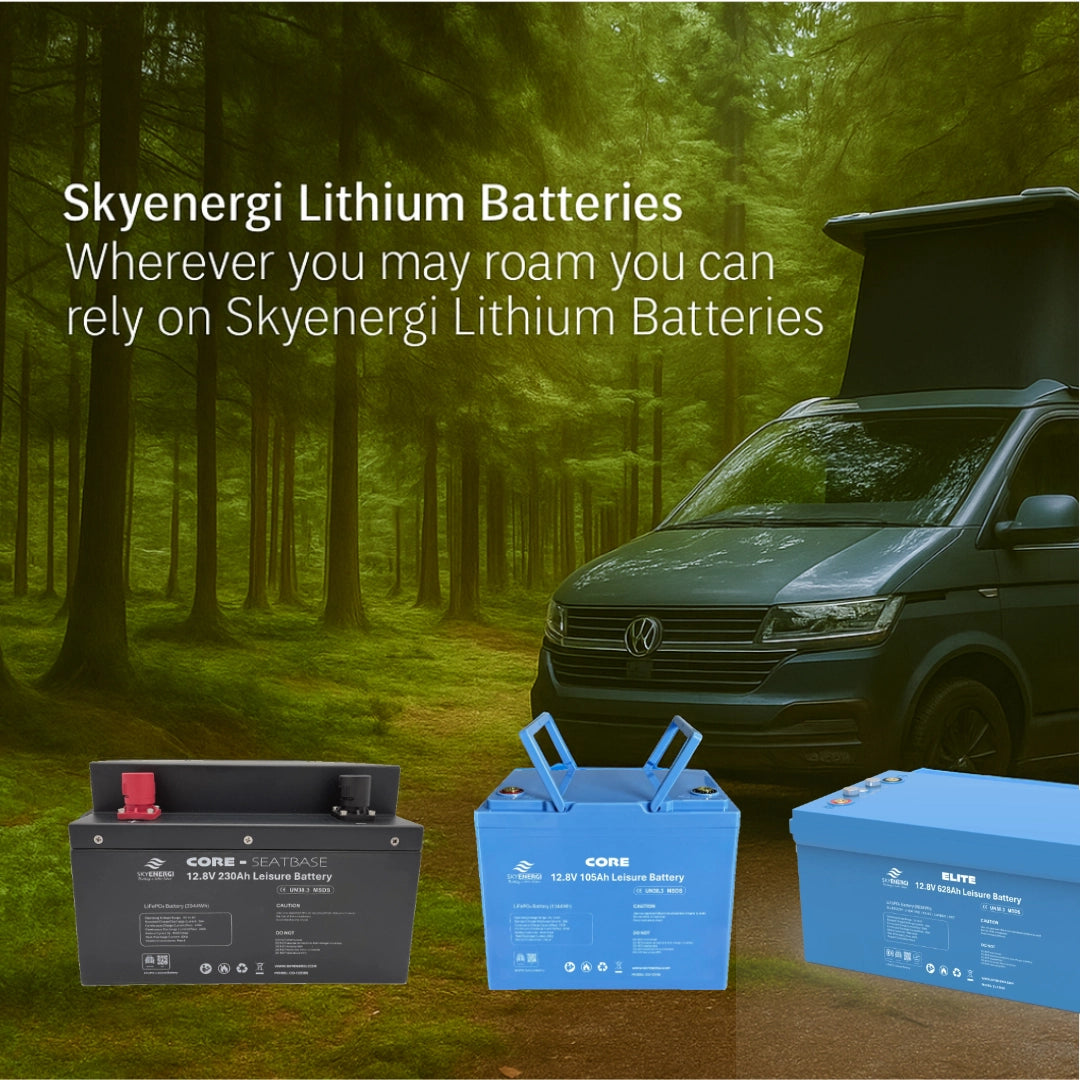Lithium vs AGM — What’s Best for Campervans?
Choosing the right leisure battery is one of the most important decisions in any campervan or motorhome build. Your battery bank runs fridges, lights, pumps, fans, inverters, charging points and more — so getting it wrong can mean flat batteries, noisy generators and cut-short trips.
The two most common options are traditional AGM (Absorbent Glass Mat) batteries and modern lithium (LiFePO₄) batteries. In this guide, we compare Lithium vs AGM specifically for campervan and van conversion use, so you can decide what’s right for your setup.

SkyEnergi lithium leisure batteries are designed for campervans, motorhomes and off-grid systems.
What Is an AGM Leisure Battery?
AGM is a type of sealed lead-acid battery where the electrolyte is held in a glass fibre mat. AGM leisure batteries have been used for years in campervans and motorhomes because they’re spill-proof, relatively robust and easy to understand.
Advantages of AGM Batteries
-
Lower upfront cost – usually cheaper to buy than lithium.
-
Widely available – easy to source replacements almost anywhere.
-
Simple charging requirements – many older chargers support AGM.
-
Familiar technology – installers and DIYers are used to working with them.
Limitations of AGM Batteries
-
Heavy – high weight for the usable energy you actually get.
-
Limited usable capacity – typically only around half the rated Ah is practical to use regularly.
-
Shorter cycle life – frequent deep discharges reduce lifespan.
-
Voltage drop under load – inverters and fridges can struggle as the battery empties.
-
Slower charging – less efficient with solar and DC-DC charging compared to lithium.
What Is a Lithium (LiFePO₄) Leisure Battery?
Lithium Iron Phosphate (LiFePO₄) is a modern battery chemistry designed for high cycle life, stable voltage and improved safety compared to many other lithium chemistries. SkyEnergi lithium leisure batteries use Grade-A LiFePO₄ cells combined with an advanced Battery Management System (BMS) for protection and monitoring.

SkyEnergi LiFePO₄ leisure batteries use premium cells and smart BMS technology.
Advantages of Lithium Batteries
-
More usable energy – a much higher percentage of the rated capacity can be used day to day.
-
Significantly lighter – ideal for payload-limited campervans and motorhomes.
-
Longer lifespan – designed for many more charge/discharge cycles than typical AGM batteries.
-
Fast charging – ideal for solar and DC-DC alternator charging.
-
Stable voltage – keeps inverters and 12V appliances happier as the battery discharges.
-
Low self-discharge – great for vans that sit between trips.
Considerations with Lithium Batteries
-
Higher initial cost – although the cost per cycle over the life of the battery is often lower.
-
Suitable chargers required – best results with lithium-compatible chargers, MPPTs and DC-DC units.
-
Cold-weather charging – lithium cells should not be charged below 0°C unless protected (for example by a heat pad or BMS logic).
Lithium vs AGM: Side-by-Side for Campervans
| Feature |
AGM Leisure Battery |
Lithium (LiFePO₄) Leisure Battery |
| Usable capacity (day to day) |
Often around half the rated Ah is practical. |
A much higher share of rated Ah can be used comfortably. |
| Typical cycle life |
Lower cycle count when regularly deep-cycled. |
Designed for far more cycles under similar usage. |
| Weight |
Relatively heavy for the energy stored. |
Often 50–70% lighter for comparable usable energy. |
| Charging speed |
Slower, prefers long absorption phases. |
Can absorb charge quickly from solar and DC-DC chargers. |
| Voltage behaviour |
Voltage drops noticeably as battery discharges. |
Voltage remains more stable until the battery is nearly empty. |
| Cold-weather charging |
Can be charged at low temperatures (with reduced performance). |
Charging below 0°C should be avoided unless cells are protected. |
| Upfront cost |
Lower purchase price. |
Higher initial investment. |
| Long-term value |
Higher cost per usable cycle over time. |
Often lower cost per cycle over the lifespan. |
Real-World Example: 100Ah AGM vs 105Ah Lithium
In a typical campervan setup:
-
100Ah AGM – in practice, many users only draw down to roughly half capacity regularly to
Prev post

Updated on 16 November 2025
Next post

Updated on 16 November 2025


